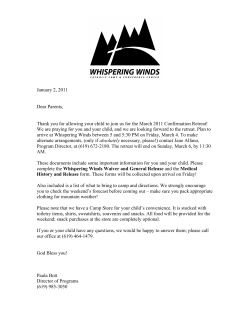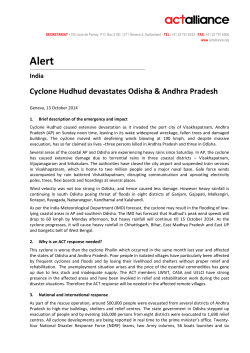
What is a Cyclone?
What is a Cyclone? Cyclones are huge revolving storms caused by winds blowing around a central area of low atmospheric pressure. In the northern hemisphere, cyclones are called hurricanes or typhoons and their winds blow in an anticlockwise circle. In the southern hemisphere, these tropical storms are known as cyclones, whose winds blow in a clockwise circle. How do Cyclones occur? Cyclones develop over warm seas near the Equator. Air heated by the sun rises very swiftly, which creates areas of very low pressure. As the warm air rises, it becomes loaded with moisture which condenses into massive thunderclouds. Cool air rushes in to fill the void that is left, but because of the constant turning of the Earth on its axis, the air is bent inwards and then spirals upwards with great force. The swirling winds rotate faster and faster, forming a huge circle which can be up to 2,000 km across. At the centre of the storm is a calm, cloudless area called the eye, where there is no rain, and the winds are fairly light. • As the cyclone builds up it begins to move. It is sustained by a steady flow of warm, moist air. The strongest winds and heaviest rains are found in the towering clouds which merge into a wall about 20-30 km from the storm's centre. Winds around the eye can reach speeds of up to 200 km/h, and a fully developed cyclone pumps out about two million tonnes of air per second. This results in more rain being released in a day than falls in a year in a city like London. Three separate systems When and where do Cyclones occur? • Cyclones begin in tropical regions, such as northern Australia, South-East Asia and many Pacific islands. They sometimes drift into the temperate coastal areas, threatening more heavily populated regions to the South. Northern Australia has about four or five tropical cyclones every year during the summertime wet season. For a cyclone to develop, the sea surface must have a temperature of at least 26ºC. Cyclone track Why do Cyclones occur? • When warm air rises from the seas and condenses into clouds, massive amounts of heat are released. The result of this mixture of heat and moisture is often a collection of thunderstorms, from which a tropical storm can develop. • The trigger for most Atlantic hurricanes is an easterly wave, a band of low pressure moving westwards, which may have begun as an African thunderstorm. Vigorous thunderstorms and high winds combine to create a cluster of thunderstorms which can become the seedling for a tropical storm. • Typhoons in the Far East and Cyclones in the Indian Ocean often develop from a thunderstorm in the equatorial trough. During the hurricane season, the Coriolis effect of the Earth's rotation starts the winds in the thunderstorm spinning in a circular motion. Cyclone Danger • Cyclones create several dangers for people living around tropical areas. The most destructive force of a cyclone comes from the fierce winds. These winds are strong enough to easily topple fences, sheds, trees, power poles and caravans, while hurling helpless people through the air. Many people are killed when the cyclone's winds cause buildings to collapse and houses to completely blow away. • A cyclone typically churns up the sea, causing giant waves and surges of water known as storm surges. The water of a storm surge rushes inland with deadly power, flooding lowlying coastal areas. The rains from cyclones are also heavy enough to cause serious flooding, especially along river areas. Katrina damage • Long after a cyclone has passed, road and rail transport can still be blocked by floodwaters. Safe lighting of homes and proper refrigeration of food may be impossible because of failing power supplies. Water often becomes contaminated from dead animals or rotting food, and people are threatened with diseases like gastroenteritis. Typhoon saomi Tornadoes The enormous tornado that struck in Moore, Oklahoma, on Monday has added a chilling entry into the list of the deadliest tornadoes on record. 22 May 2013 • The event has many recalling a recordbreaking tornado that struck in precisely the same region in 1999, during which the fastest winds ever seen on the Earth's surface were recorded: over 500km/h (310mph). • In simplest terms, warm, wet air blowing in from the Gulf of Mexico meets cold, dry air coming from the massive Rocky Mountain range, hemmed in by air masses on the eastern part of the country. That frequently creates the conditions for grand thunderstorms. • There are more tornadoes in total being recorded in recent years, mainly due to better reporting and fewer truly unpopulated areas where they would go unseen. • Yet there is no indication that the frequency of large tornadoes is increasing. While 2011 saw the largest number of storms among records dating back to 1954, 2012 was among the lowest • And the average number of fatalities caused by tornadoes has been steadily declining since 1925 - before Monday's storm, only one of the 25 deadliest tornadoes occurred in the last 58 years, and most of that list stretches back further than a century. • Much of this can be attributed to better building codes and increasingly advanced warning systems in affected areas - the National Weather Service in Oklahoma issued a warning 16 minutes before the storm hit. • But such warning systems can only give a rough indication of an area in which conditions are almost certain to spark tornadoes; what they cannot provide is a precise prediction of where a tornado will touch down. Multi-vortex Sequence of formation texas waterspout Dust devil Levelled house
© Copyright 2025





















